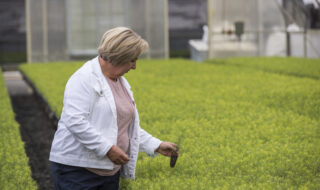NEW NFIB SURVEY: Small Business Optimism Improves Again
NEW NFIB SURVEY: Small Business Optimism Improves Again
September 9, 2025
Main Street cites labor quality as the top issue
WASHINGTON, D.C. (Sept. 9, 2025) – The NFIB Small Business Optimism Index rose 0.5 points in August to 100.8, nearly 3 points above the 52-year average of 98. Of the 10 Optimism Index components, four increased, four decreased, and two were unchanged. The increase in those expecting real sales to be higher contributed the most to the rise in the Optimism Index. The Uncertainty Index fell by 4 points to 93 but remained well above the historical average. The decline was due to a decrease in uncertainty about financing expectations and planned capital expenditures.
“Optimism increased slightly in August with more owners reporting stronger sales expectations and improved earnings,” said NFIB Chief Economist Bill Dunkelberg. “While owners have cited an improvement in overall business health, labor quality remained the top issue on Main Street.”
Key findings include:
- In August, there was a notable improvement in overall business health. When asked to rate the overall health of their business, 14% reported excellent (up 1 point), and 54% reported it as good (up 2 points). Twenty-seven percent reported the health of their business as fair (down 4 points), and 4% reported poor (unchanged).
- The percent of small business owners reporting labor quality as the single most important problem for their business remained at 21%, continuing to rank as the top problem.
- In August, 32% (seasonally adjusted) of all owners reported job openings they could not fill in the current period, down 1 point from July. The last time unfilled job openings fell below 32% was in July 2020.
- The net percent of owners expecting higher real sales volumes rose 6 points from July to a net 12% (seasonally adjusted). This component contributed the most to the Optimism Index’s increase.
- A net 0% (seasonally adjusted) of owners viewed current inventory stocks as “too low” in August, up 3 points from July.
- The net percent of owners raising average selling prices fell 3 points from July to a net 21% (seasonally adjusted), the lowest reading of this year.
- The frequency of reports of positive profit trends improved 3 points to a net negative 19% (seasonally adjusted). August’s reading was the best since March 2023.
- In August, the average rate paid on short maturity loans was 8.1%, down 0.6 points from July and the lowest reading since May 2023.
- Twenty-three percent of all owners reported borrowing on a regular basis, down 2 points from July. The last time the percent of business owners borrowing on a regular basis was below 23% was in November 2021.
As reported in NFIB’s monthly jobs report, a seasonally adjusted 32% of all small business owners reported job openings they could not fill in August, down 1 point from July. The last time unfilled job openings fell below 32% was in July 2020. Twenty-eight percent had openings for skilled workers (down 1 point), and 13% had openings for unskilled labor (up 1 point).
The difficulty in filling open positions is particularly acute in the construction, manufacturing, and transportation industries. Nearly half (49%) of small businesses in the construction industry had a job opening they could not fill, down 6 points from July and 11 points below last year’s level. This suggests a softening in the job market. Openings were the lowest in the wholesale and finance industries.
A seasonally adjusted net 15% of owners plan to create new jobs in the next three months, up 1 point from July and the third consecutive monthly increase, a positive trend but historically low.
Of the 53% of owners hiring or trying to hire in August, 81% reported few or no qualified applicants for the positions they were trying to fill. Twenty-six percent of owners reported few qualified applicants for their open positions (down 3 points), and 17% reported none (down 2 points).
In August, 21% of small business owners cited labor quality as their single most important problem, unchanged from July and remaining the top single most important problem. Labor costs reported as the single most important problem for business owners fell 1 point from July to 8%.
Seasonally adjusted, a net 29% reported raising compensation, up 2 points from July. A seasonally adjusted net 20% plan to raise compensation in the next three months, up three points from July.
Fifty-six percent of small business owners reported capital outlays in the last six months, up 1 point from July, but remaining historically low.
Of those making expenditures, 37% reported spending on new equipment, 22% acquired vehicles, and 17% improved or expanded facilities. Thirteen percent spent money on new fixtures and furniture and 5% acquired new buildings or land for expansion.
A net negative 9% of all owners (seasonally adjusted) reported higher nominal sales in the past three months, unchanged from July.
The net percent of owners reporting inventory gains rose 2 points to a net negative 6%, seasonally adjusted. Not seasonally adjusted, 10% reported increases in stocks, and 14% reported reductions. A net 0% (seasonally adjusted) of owners viewed current inventory stocks as “too low” in August, up 3 points from July. A net 1% (seasonally adjusted) of owners plan inventory investment in the coming months, unchanged from July.
Over half (54%) of small business owners reported that supply chain disruptions were affecting their business to some degree, down 10 points from July. Three percent reported a significant impact (down 1 point), 15% reported a moderate impact (down 2 points), 36% reported a mild impact (down 7 points), and 44% reported no impact (up 8 points).
Looking forward to the next three months, seasonally adjusted, a net 26% plan to increase prices, down 2 points from July. The net percent of owners raising average selling prices fell 3 points from July to a net 21%, seasonally adjusted, the lowest reading of this year. Unadjusted, 33% of owners reported higher average prices and 13% reported lower average selling prices. Eleven percent of owners reported that inflation was their single most important problem in operating their business (higher input costs), unchanged for the third consecutive month.
The frequency of reports of positive profit trends improved 3 points from July to a net negative 19% (seasonally adjusted) in August. Among owners reporting lower profits, 37% blamed weaker sales, 18% cited the rise in the cost of materials, 10% cited price change for their product(s) or service(s) and 9% cited labor costs. Among owners reporting higher profits, 65% credited sales volumes, 18% cited usual seasonal change, and 5% cited higher selling prices.
Four percent of owners reported that financing and interest rates were their top business problem in August, unchanged from July. Twenty-three percent of all owners reported borrowing on a regular basis, down 2 points from July. The last time the percent of business owners borrowing on a regular basis was below 23% was in November 2021. A net 3% reported their last loan was harder to get than in previous attempts, down 1 point from July. A net 6% reported paying a higher rate on their most recent loan, up 1 point from July. In August, the average rate paid on short maturity loans was 8.1%, down 0.6 points from July and the lowest reading since May 2023.
The net percent of owners expecting better business conditions fell 2 points from July to a net 34% (seasonally adjusted). In August, 14% (seasonally adjusted) reported that it is a good time to expand their business, down 2 points from July.
Seventeen percent of small business owners reported taxes as their single most important problem, unchanged from July and ranking as the second top problem. The percent of small business owners reporting government regulations and red tape as their single most important problem rose 1 point to 9%. Five percent reported competition from large businesses as their single most important problem, down 1 point from July.
The NFIB Research Center has collected Small Business Economic Trends data with quarterly surveys since the fourth quarter of 1973 and monthly surveys since 1986. Survey respondents are randomly drawn from NFIB’s membership. The report is released on the second Tuesday of each month. This survey was conducted in August 2025.
NFIB is a member-driven organization advocating on behalf of small and independent businesses nationwide.
Related Articles














